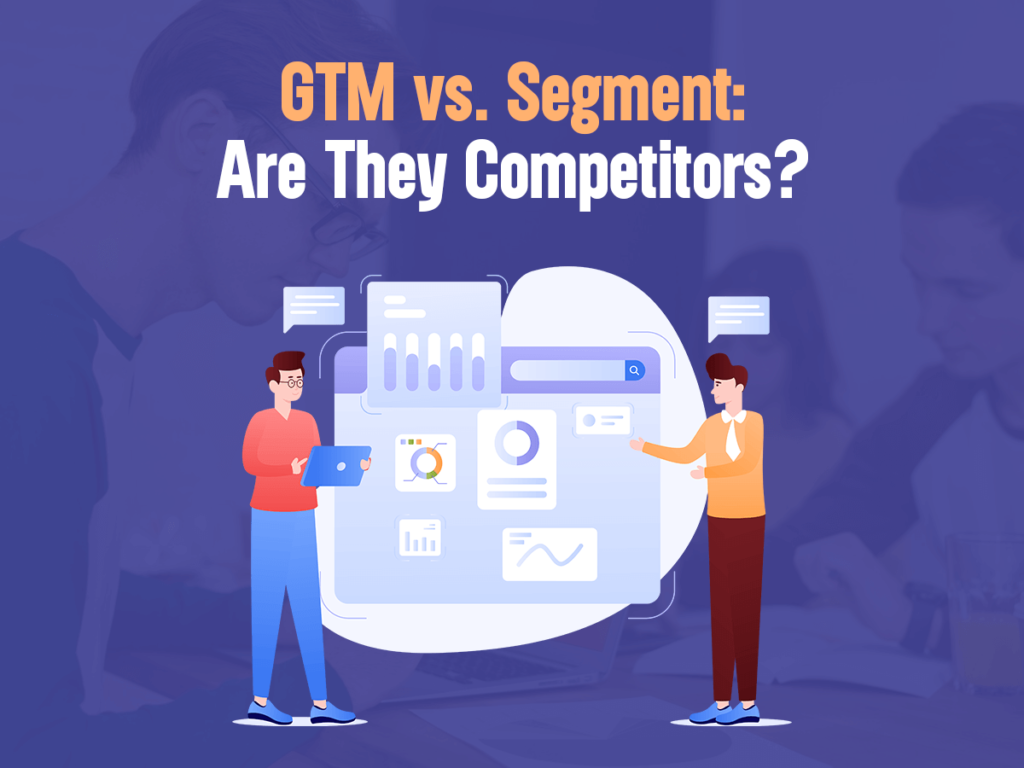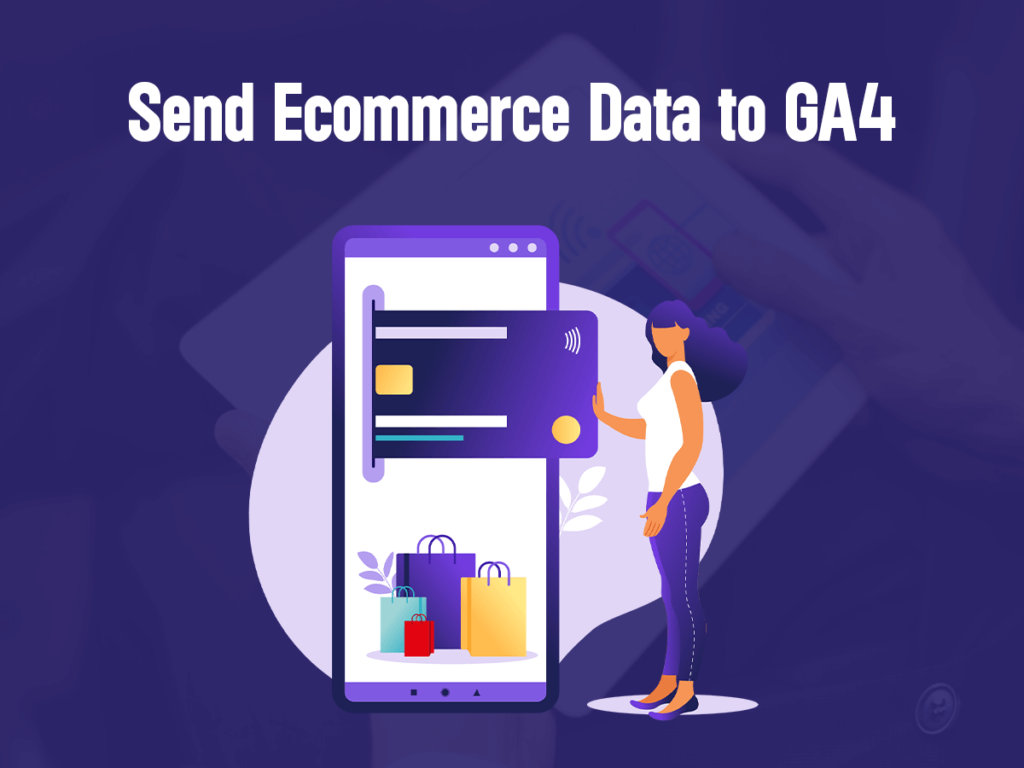Two Different Versions of Google Analytics 4
GA4 is offered in two different versions: GA4 Standard & GA4 360. The GA4 360 & GA4 standard both have the same user interface.
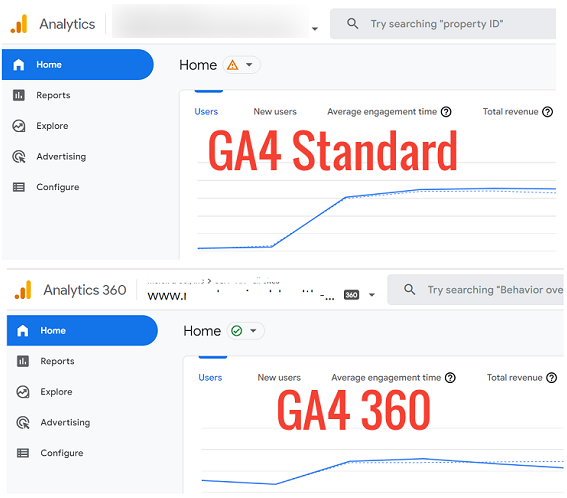
The free form of a GA4 property is referred to by a GA4 standard. However, The GA4 property’s paid version is referred to as 360.
Pricing & Billing of GA4 360
One particular offering from the platform of Google Marketing is GA4 360, the subscription service for which an individual must pay a monthly charge.
With the properties of GA4 360, the charges will be according to the chargeable hit volume, and that has a chargeable sum for other products of 360 you utilize. Through a Google Marketing account, you can control invoicing and keep track of chargeable hit volume.
Prime Differences Among GA4 360 & GA4 Standard
1. Free versus Paid
The standard or free variant of the Google Analytics 4 property is referred to as a GA4 standard. GA4 360, on the other hand, involves the paid/premium edition of the Google Analytics 4 property.
In short, It costs nothing to utilize GA4 Standard. In contrast, GA4 360 isn’t.
2. Accuracy & Data Processing
Contrary to GA4 360, one cannot depend upon Google Analytics 4 standard property for high accuracy and a vast amount of data processing. This is due to the increased data limits for the data processing and collection that come with the GA4 360 subscription as compared to a GA4 standard.
In this case, if a website receives more than one million visitors per month, then GA4 360 is the better option for you.
3. Analytics at Enterprise-level
In contrast to a GA4 standard, a GA4 360 is mainly intended for big enterprises. The subscription of GA4 360 offers enterprise standard technical assistance & service-level contract for data retention, data collection, data reporting, BigQuery export, and attribution.
4. Technical Support
The GA4 360 membership includes a devoted account manager & support personnel that can assist you with any questions you may have about data reporting and data collection.
But, if you utilize a GA4 standard, you must make use of the community forums or self-help centre. You are all by yourself.
5. Accessibility
Every person or organization can immediately access and use a Google Analytics 4 standard property. Nevertheless, you must first speak with an enterprise sales spokesperson or contact a sales partner of Google to access and use a Google Analytics 4 360 property.
Moreover, the estimated annual cost of GA4 360 is around $ 150k or higher. Thus, most people cannot afford a GA4 360 membership.
6. Legal Requirements
You would have to sign the GA4 property’s 360 contracts with the purpose to utilise GA4 360. You can upgrade the GA4 standard to a GA4 360 property once the contract has been signed.
You can utilize the Google Analytics 4 standard property without signing any agreements.
7. Data limits
In comparison to GA4 Standard, GA4 360 offers higher restrictions for data reporting collection, retention, and BigQuery export. One of the major advantages of using GA4 360 is data limits.
8. Data Freshness
A GA4 360 offers better data freshness than a GA4 standard. By using GA4 360, you can access ongoing intraday data through the API and user interface. Usually, the data is available an hour after it was collected.
Data freshness determines the total time GA4 takes to gather and process the data of an event from a website or application & then allow event data accessible through the API or user interface. If the procedure is completed in 1 hour, then the data freshness is considered as 1 hour. As opposed to a GA4 standard, data freshness is ensured after the subscription of GA4 360.
9. Event Parameters
This is a piece of additional information or data related to the GA4 event which is sent with the event. For instance, for the “page_view” GA4 event name, the few possible event parameters are given below;
- page_location
- Source
- page_title
- Medium
- page_referrer

You are allowed to send about 25 parameters for each event while using the Google Analytics 4 standard property. But, you may send around 100 parameters for each event, if you are utilizing the Google Analytics 4 360 property.
As a result, using GA4 360 allows you to send event additional information
10. Event-Scoped Custom Dimensions
The event parameter in terms of GA4 is the custom dimension.
Utilize the custom dimension if you wish to determine the user characteristic that is unmeasurable by any other default dimension.
For instance, you could design your personal dimension to keep track of client IDs.
Two types of custom dimensions exist:
1. Event-Scoped
The event-scoped dimension is the custom dimension whose value is sent and calculated for every event.
2. User-scoped
The term “event-scoped custom dimension” refers to the custom dimension which has the “event” scope.
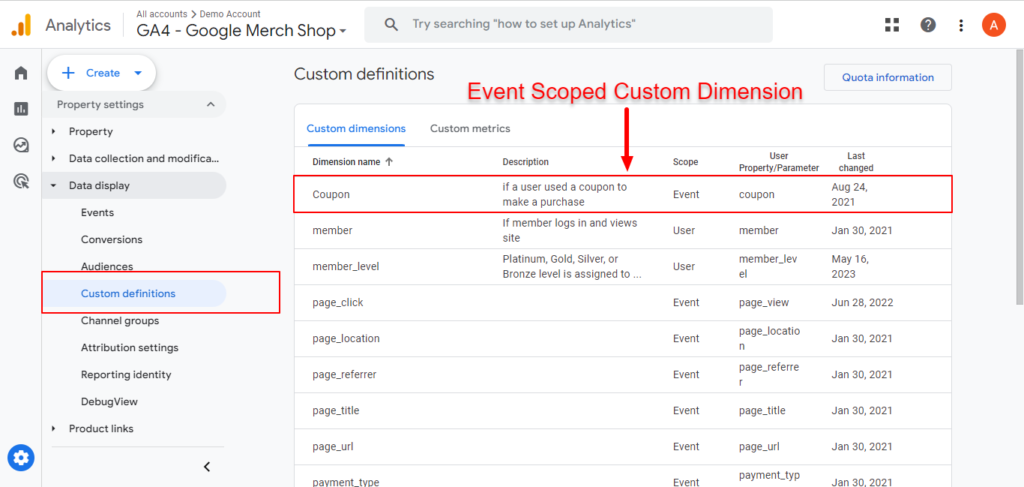
In the Google Analytics 4 standard property, you are allowed to create around 50 of these custom dimensions, Google Analytics 4 360 property allows you to create around 125 of these custom dimensions.
11. Event-Scoped Custom Metrics
The event parameter in terms of GA4 is the custom metric.
Utilize the custom metric if you wish to determine the dimension characteristic that is unmeasurable by any other default metric. You could, for instance, develop your metrics to keep track of the total number of phone calls the traffic source generates. A custom metric’s value is computed and transmitted for every event in GA4. The custom metric, in other terms, has the “event” scope.
Because of this, the GA4 custom metric is also known as the “event-scoped custom metric”
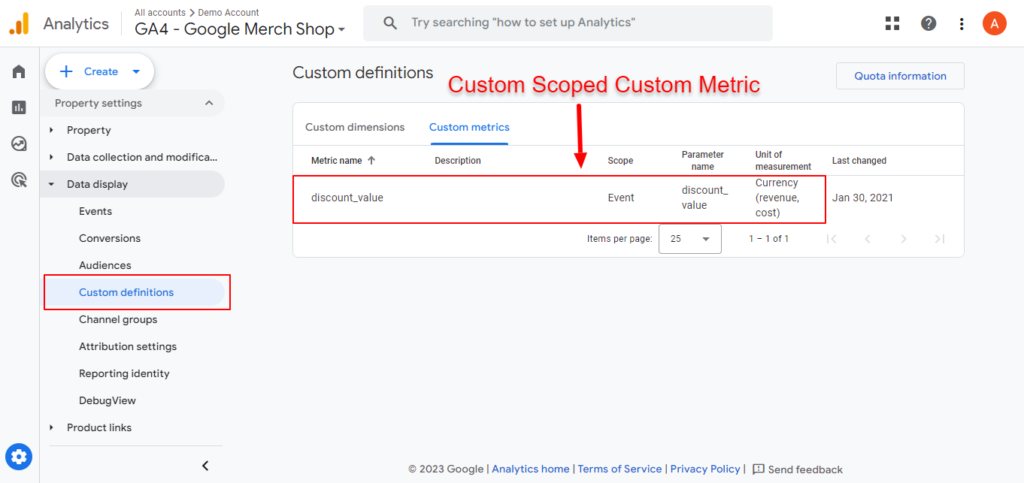
In the Google Analytics 4 standard property, you are allowed to create around 50 of these custom metrics. While Google Analytics 4 360 property allows you to create around 125 of these custom metrics.
12. User-scoped Custom Dimensions
A Google Analytics 4 custom dimension that is user-scoped is one whom value is computed and sent one time for every user. To put it another way, the custom dimension with the “user” scope is referred to as a user-scoped custom dimension.
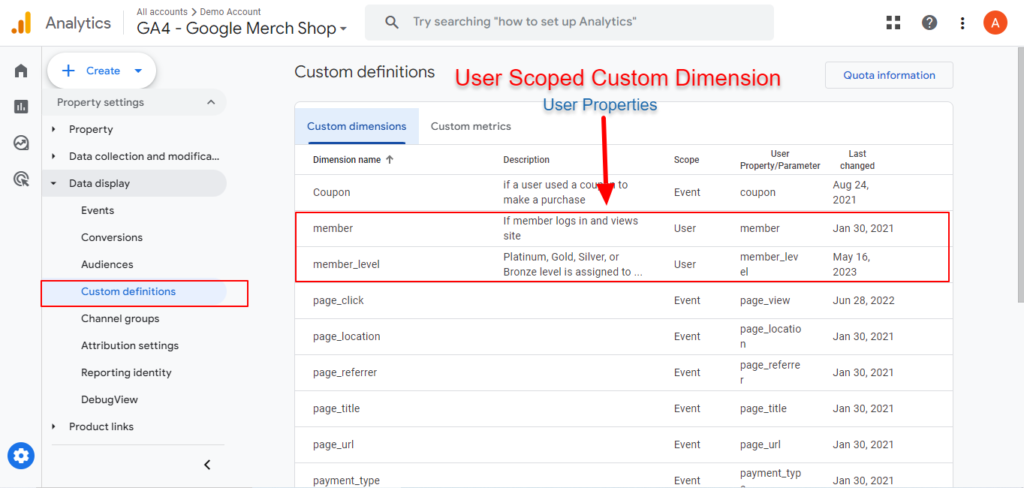
Google advises using the user-scoped dimension for identifying the constant and slowly changing properties of application or website users. These properties could include adjustments to a subscription plan, degree of membership, game complexity, etc.
In the Google Analytics 4 standard property, you are allowed to create around 25 of these custom dimensions. While Google Analytics 4 360 property allows you to create around 100 of these custom dimensions.
13. Conversion
One of the goals of putting up a website or a mobile app is conversion.
The conversion examples are as follows:
- Newsletter signups
- The quantity of orders
- The quantity of downloads
According to GA4, conversions are events.
In GA4 to define a conversion, we symbolize the event as a conversion.

Because of this, the conversion is referred to as the “Conversion Event”
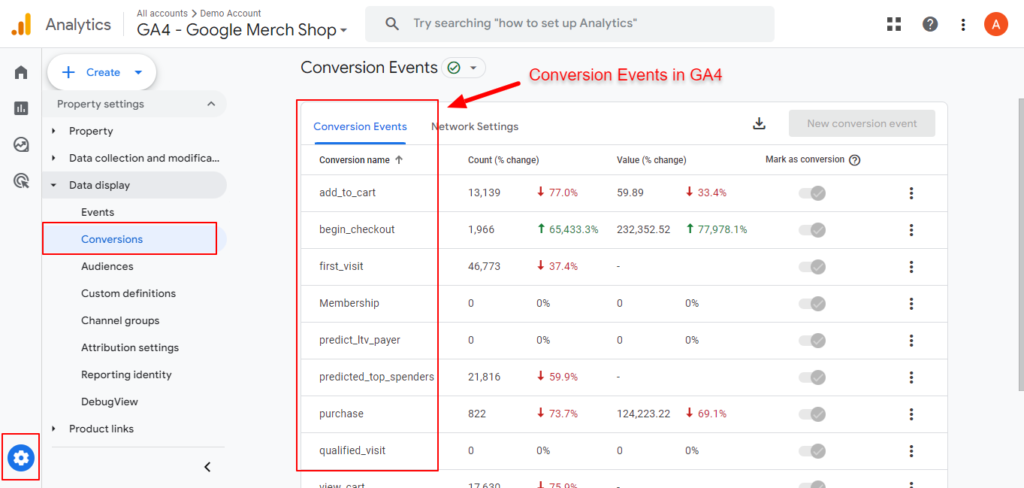
In the Google Analytics 4 standard property, around 30 events can be marked as conversions. While, in Google Analytics 4 360 property, around 50 events can be marked as conversion.
14. Audience
According to GA4, the audience, often referred to as the cohort, is the group of people who have common experiences, characteristics, and attributes in a specific period.
A few examples of the audiences include:
UK audience: a population of users based in the United Kingdom.
Desktop Audience: the group of individuals who accessed the website or app using a desktop gadget.
Facebook audience: the group of individuals who accessed the website or app from Facebook.
Purchasers: The users who bought something from your website or app.
A user may be a part of two/more two audiences simultaneously.
For instance, If a person from the United Kingdom (UK) used a desktop computer to access your website and clicked on a Facebook android to buy something, he is then included in the audience given below:
- UK audience
- Purchasers
- Facebook Audience
- And Desktop audience
A custom audience is an audience that is created from scratch.
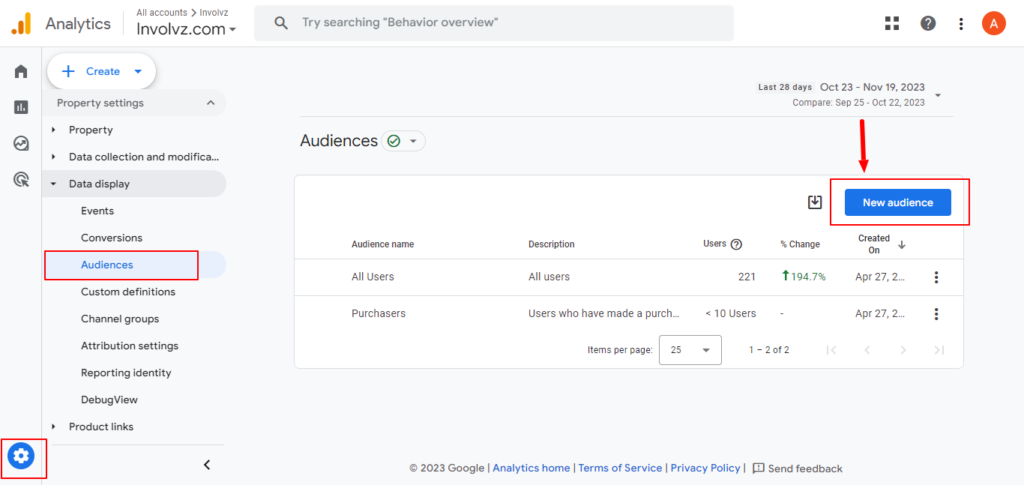
Another option is to use a pre-made audience template in GA4 to build the custom audience:
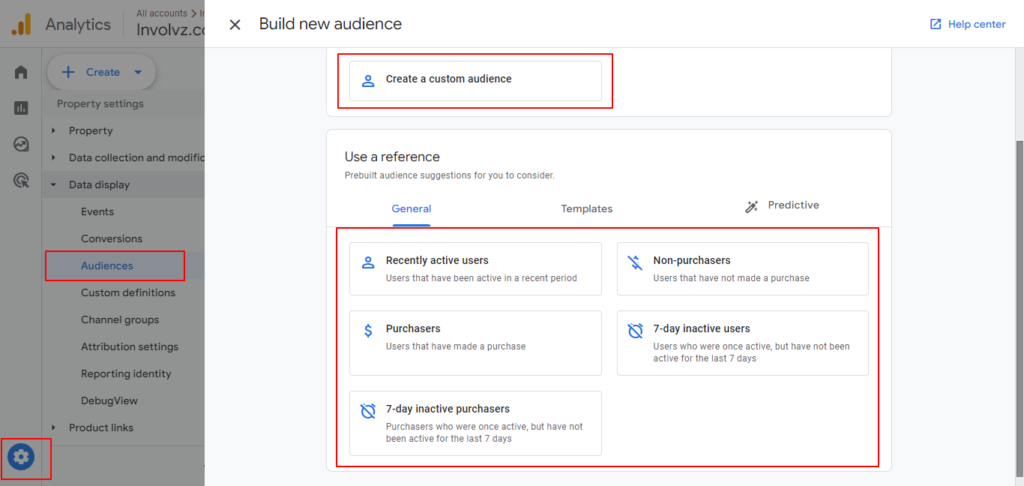
15. Explorations Report
The frequent question that may come to mind is why Google Analytics 4 does not provide as much reports as GA3, it is because Google prefers that you utilize Looker Studio ( previously called the Google Data Studio) to make your reports or for reporting reasons from scratch by utilizing the templates of Explorations report.
With the report templates in Explorations, you can perform advanced analysis.
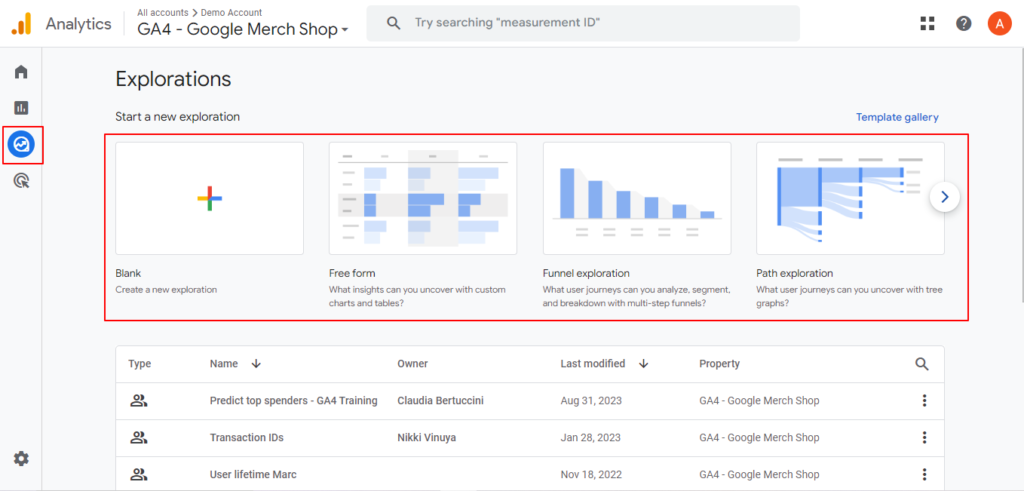
Tap on the link for the template gallery to view the list of templates for an Explorations report.


The following report templates are available in GA4:
- Blank– Use this blank template to start from scratch while creating the exploration report.
- Free Form– Utilize a free-form report template for discovering insights utilizing tables and charts.
- Funnel exploration– Use a funnel exploration report template for funnel analysis and creation.
- Path exploration– Determine the order of pages visitors visited & the actions they took through the path exploration report template.
- Segment Overlap– Determine the behavior of users by the segment of users’ overlapping through this template.
- Cohort Exploration-Use cohort exploration report template for behavior analysis of the set of users who exhibit similar characteristics.
- User lifetime– Utilise this template to examine your website or app user’s behavior since they initially visited it.
Create one and more than one exploration report by using the report templates.
Also, you can share the exploration reports among other GA4 property users. Such reports are known as shared exploration reports.
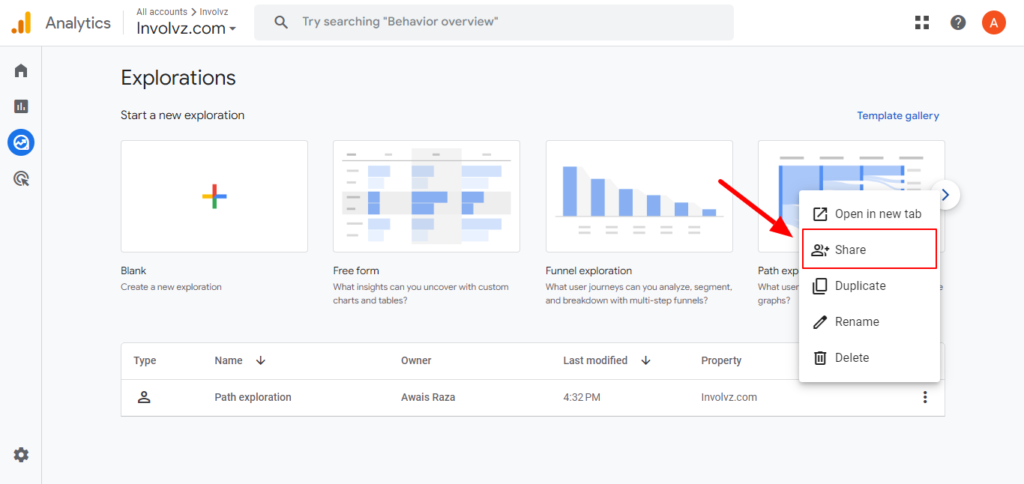
In GA4, you can create around 200 exploration reports per user per property and approximately 500 shared exploration reports per property.
While GA3 360 permits each user to create around 200 exploration reports per user per property and approximately 1000 shared exploration reports per property.
16. A sampling of data for the exploration reports
The method of reporting and analyzing the subset of traffic data is called data sampling. Large data collections must be analyzed quickly and affordably.
A sample is a subset of the traffic data. This isn’t an entire set of traffic data. In contrast, Unsampled data is an entire set of traffic data. If a sample represents all data exceptionally, analyzing the sample yields the same results as those obtained from analyzing the whole data.
If the chosen sample isn’t well representative of the entire data or it is insufficient then the analysis of a subset of the data doesn’t produce the same results as the analysis of the whole data.
GA4 has a certain limit upon the volume of traffic data that won’t sample to generate reports. For resource conservation, the limits have been set ( costs and computation power)
Depending on the user’s query, GA4 may decide to analyze an entire set of traffic data or just a single subset of the traffic data.
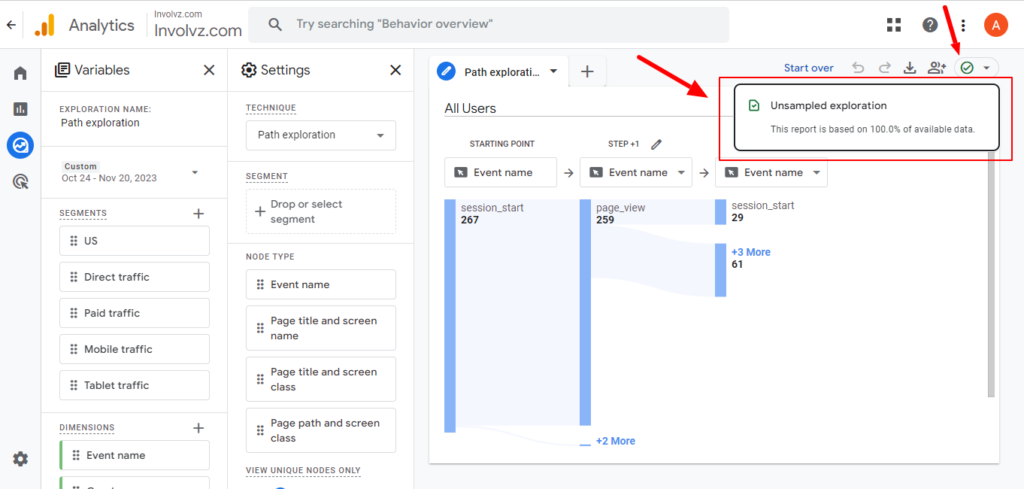
You shouldn’t rely on the metrics GA4 reports when it only analyses a tiny subset of the traffic data since a selected sample might not be an accurate representation of the entire traffic data set. Sample size affects the report of traffic data, the smaller sample size gives unreliable results. So, it is better to avoid sampling of data wherever possible.
As far as you don’t query beyond 10 (ten) million events at once, exploration reports for the GA4 standard are not dependent upon the sampled data. As far as you don’t query beyond 1 (one) billion events at once, exploration reports for GA4 360 aren’t dependent upon sampled data.
17. Unsampled data for the exploration reports
If exploration results are presently being sampled & you utilize GA4 360, then you can ask for unsampled data for the exploration report.
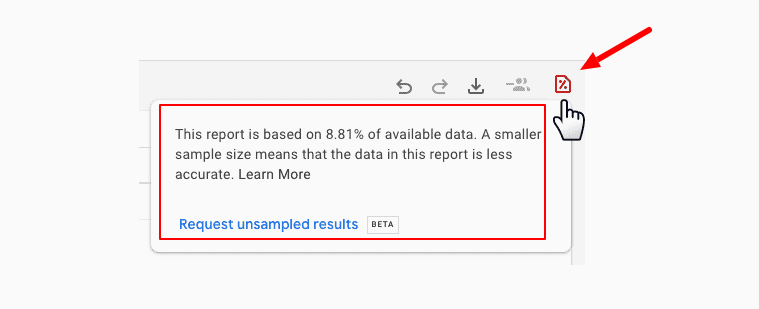
The exploration findings, which contain around 15 (fifteen) billion events, are available as unsampled data. For exploration reports, the GA4 standard doesn’t offer the option to request unsampled data.
18. Data Retention
You can specify how long Google Analytics should keep the user-specific data on inactive users of a website before removing it automatically, through this feature. The data linked to cookies, advertising identifiers, or user Ids is referred to as user-specific data.
You have two options for the setting of data retention in Google Analytics 4 standard property: 2 months or 14 months.

You can select the settings for data retention in Google Analytics 4 360 property from the following:
- Two (2) months
- Fourteen (14) months
- Twenty-six (26) months
- Thirty-eight (38) months
- Fifty (50) months

19. BigQuery Export limit
Business intelligence is delivered in the dashboard and reports form by using Google BigQuery, which is the data warehouse at the enterprise level from Google.
It is a system for managing and storing data that is used for reporting and analysis purposes. Examples of these data sources include Google Ads, GA4, Bing Ad Manager, Facebook Ads, and others.
BigQuery enables data manipulation via GA4 that is frequently simply not achievable while using the Google Analytics 4 user interface. When accessing analytics data via the API or the Google Analytics 4 user interface, most restrictions are removed by BigQuery. The use of BigQuery has many benefits. Advanced data analysis and segmentation are made feasible through this. In contrast to GA3 (also known as Universal Analytics), GA4 offers a free-cost connection to it.
You just have to connect the BigQuery project to the GA4 property, and enable and set up BigQuery API, after which you can use BigQuery to query the necessary GA4 data.

In BigQuery, the following data tables include your GA4 data:

- Data table- events _ it contains all of the Google Analytics 4 event information from the past day(s)
- Data table- events_intraday_ it contains all the Google Analytics 4 event information from the present time.
Raw event data can be exported from the GA4 property to BigQuery and SQL can be used for querying the data. Yet, Google has placed restrictions upon the quantity of data that can be exported from the Google Analytics 4 property to BigQuery on any day.
The daily export limit for a Google Analytics 4 standard property is one million events. However, the daily export limit for the Google Analytics 4 360 property is billions of events.
20. Subproperties
A GA4 property that receives the event data through other GA4 property is referred to as a sub-property (also known as source property).
In GA4, when you wish to create the filtered reporting site, establish a sub-property. You can create sub-properties with a GA4 360 subscription:

If you utilize the Google Analytics 4 standard property, you cannot build sub-properties.
21. Rollup Properties
It is a unique kind of GA4 property in which event data is derived from other Google Analytics 4 properties (also called source properties). Two or more two source properties make up the rollup property. If you wish to configure this reporting in the GA4, create the rollup property. It is reporting of the data in the assembled form from several digital properties ( mobile apps, websites).
It enables you to:
- Combine all of the data from your websites into a single reporting view.
- See the worldwide performance metrics as a whole.
- Compare the performance of different websites to one another.
Create the roll-up properties by using a GA4 360 subscription:
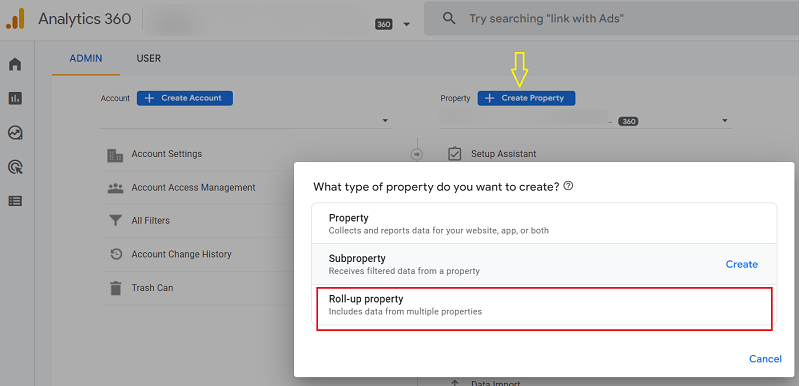
If you utilize the Google Analytics 4 standard property, you cannot build rollup properties.
22. Automatic Custom Tables
Automatic custom tables are enabled for all reports in the GA4 360 property, so the data is assembled below the “(other)” row for high cardinality dimensions.

Automatic custom tables are disabled for a Google Analytics 4 standard property. When GA4 reports above than 500 distinct values for a given dimension in a single day, the dimension has a high cardinality.
Data can assemble below the “(other)” row when the cardinality of the dimension is high.
23. Product Integration
Standard Google Analytics 4 property works with another standard form of Google products ( such as Ad Manager, Google Ads, search console, Merchant Center, etc.)
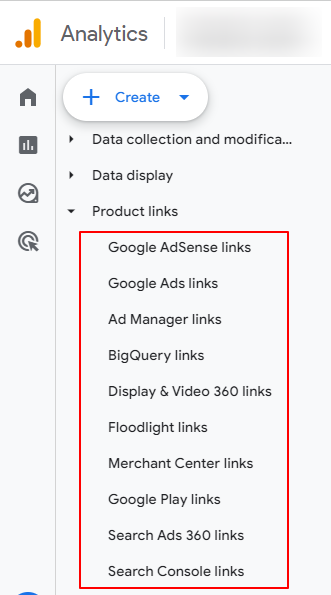
However, GA4 360 property is compatible with both the standard & 360 forms of Google products ( such as Display and video 360, Search Advertisements 360, etc.)

24. CRM integration
In contrast to the Google Analytics 4 standard property, GA4 360 property has native integration capabilities with CRMs such as Salesforce Marketing Cloud. You can get GA4 data in Salesforce using such integration.
25. Native Remarketing Integration
This integration with Google Ads is best suited to the GA4 standard. Although GA4 360 is most suited for this integration with Display and video 360 & Google Ads.
Read Our Latest Guides on GA4:

